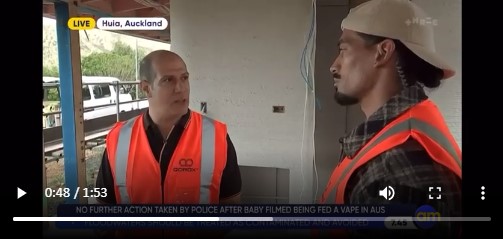Concrete houses created using 3D printing technology is being touted as a possible remedy to New Zealand’s housing crisis.
The technology was on show in Hamilton on Thursday during a lunchtime demonstration in Garden Place.
Hamilton-based company QOROX had been recruited by the city council to create a stylised park bench using 3D-printed concrete.
The waka-inspired bench was created using a robot imported from the Netherlands. The robot and its large mechanical arm are capable of constructing a range of concrete structures, including houses and commercial buildings. It’s also been used to build a bridge.
“We’re effectively limited right now only by our imagination – and physics,” QOROX director Wafaey Swelim said.
Swelim, an architectural engineer, said automation is crucial to New Zealand achieving its building and construction aspirations.

Building houses and commercial buildings using 3D-printed concrete went from an idea to an actual product in Europe about five years ago. However, the idea is only starting to be grasped in the Southern Hemisphere.
“When I moved to New Zealand in 2015 I realised that construction is a little bit behind,” Swelim said.
“The future in construction is in automation, it’s not trying to do the same thing over and over again. Unfortunately, the automation [in New Zealand] stops in the manufacturing process and it has not crossed over to construction sites.”
While a 3D printed house costs about the same as a traditional timber-framed house, it can be built a lot quicker.
Swelim said his robot – which was purchased from CyBe Construction in the Netherlands – can print the walls of a house in one week at speeds of up to 4.5sqm an hour.

The concrete houses still incorporate conventional building elements.
“You’re not going to print the roof or the [floor] slab, there are traditional elements that are going to be there but generally you can have weathertight walls within a week.”
To comply with the New Zealand Building Code, the walls have to be reinforced.
CyBe Construction founder Berry Hendriks and two engineers were flown to New Zealand ahead of the robot’s debut. A second public demonstration will be held at Auckland’s Aotea Square on Friday.

Quick-drying concrete, using active compounds imported from Europe, are used in the 3D-printing process, allowing the concrete to set in five minutes. Oxides can be added to the concrete to produce different colours.
Swelim said Hamilton City Council and Auckland Council have been receptive to the new technology as have a range of builders and architects.
CyBe Construction has partners around the world who share designs and ideas with each other.
“The only way for us to evolve quickly and have a decent footprint in the [construction] market is if we share the knowledge rather than working in silos.”
Swelim expects the costs associated with 3D-printed concrete to decline as the technology evolves.
“It’s like smart phones and laptops and electric cars, it starts at a high point. Once you have economy of scale, the price will come down.
“This is the first generation of robots. They always get better and cheaper.”
The robot can 3D print concrete objects onsite or offsite. It can also operate on a 24/7 basis if demand justifies it.
The 3D printed park bench will remain in Garden Place until early 2021 and then be moved to Hayes Paddock as part of a playground upgrade.



